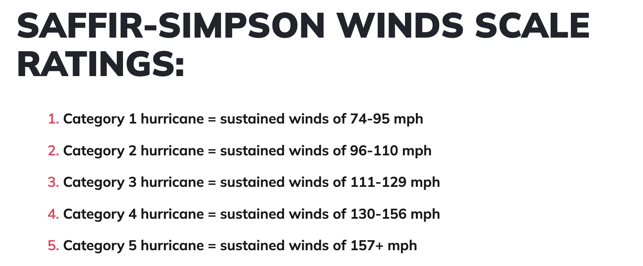 Covering COVID-19 is a daily Poynter briefing of story ideas about the coronavirus and other timely topics for journalists, written by senior faculty Al Tompkins. Sign up here to have it delivered to your inbox every weekday morning.
Covering COVID-19 is a daily Poynter briefing of story ideas about the coronavirus and other timely topics for journalists, written by senior faculty Al Tompkins. Sign up here to have it delivered to your inbox every weekday morning.
Hurricanes are assigned a strength rating from one to five on the Saffir-Simpson scale. What do those rankings actually mean? Let’s start with the categories and then explore what is likely to happen at each level.
First, understand that a Category 2 storm does not cause double the damage of a Category 1 storm. No, it is four times more damage. Each level increases the damage factor by four.
That means a Cat 3 storm is eight times more destructive than a Cat 1, a Cat 4 storm is 12 times more destructive than a Cat 1, and a Cat 5 is 16 times the destruction of a Cat 1. It is a similar concept to the scale used for earthquakes.
The hurricane scale is named after Herbert Saffir, an engineer, and Robert Simpson, a meteorologist. They developed the scale in the early 1970s to describe the likely effects that hurricanes could have on an area. Initially, Saffir and Simpson created the scale based solely on wind speed.

(Saffir-Simpson scale wind speeds)
If you want to get really nerdy, watch the barometer. As pressure falls, the wind speed and hurricane category will rise. In general terms, greater than 979 millibars is a Category 1 hurricane, 965 to 979 millibars is Category 2, 945 to 964 is Category 3, 920 to 944 is category 4, and less than 920 millibars is a Category 5 storm.
But the problem with this scale is that it is based on wind speed and, while wind does cause damage, storm surge is also a big concern for coastal areas. As the National Park Service notes, “For instance, based on wind speed, Hurricane Katrina (2005) initially came ashore in Florida as a category 1 hurricane and made a second landfall in Louisiana as a category 3. However, storm surge associated with Hurricane Katrina was over 30 ft (9 m) in some areas, which would classify it as a category 5 hurricane.”
Keep in mind that storms generally lose strength quickly as soon as they come ashore. The National Hurricane Center notes:
It is also important to note that peak 1-minute winds in hurricane are believed to diminish by one category within a short distance, perhaps a kilometer [~ half a mile] of the coastline . For example, Hurricane Wilma made landfall in 2005 in southwest Florida as a Category 3 hurricane. Even though this hurricane only took four hours to traverse the peninsula, the winds experienced by most Miami-Dade, Broward, and Palm Beach County communities were Category 1 to Category 2 conditions. However, exceptions to this generalization are certainly possible.
The Saffir-Simpson scale does not take into consideration rainfall or tornado potential. And it does not take into account the fact that the storm could hit two different places and cause different amounts of damage. Here is why:
These windcaused damage general descriptions are to some degree dependent upon the local building codes in effect and how well and how long they have been enforced. For example, building codes enacted during the 2000s in Florida, North Carolina and South Carolina are likely to reduce the damage to newer structures from that described below. However, for a long time to come, the majority of the building stock in existence on the coast will not have been built to higher code. Hurricane wind damage is also very dependent upon other factors, such as duration of high winds, change of wind direction, and age of structures.
With those caveats, the general expected damage from each category is:
Hurricanes are getting stronger. Do we need a Category 6?
Does the Saffir-Simpson scale stop too soon for modern hurricanes? It is a conversation that experts have been kicking around for a while. Mic.com reports:
Category Five serves as a sort of catch-all for all powerful storms, and it doesn’t fully capture just how bad things can get. The Saffir-Simpson Scale increases the storm rating every 15 mph, and Hurricane Dorian (2019) produced winds much more than 15 mph faster than Category Five captures. If the scale extended to a Category Six rating, Dorian would have qualified.
Dorian won’t be the last storm to push the limits of the Category Five label, either. As the planet warms, the result of human-caused climate change, it creates the conditions that hurricanes thrive in: warmer water and wetter air. The result, researchers have found, is more hurricanes that would otherwise be less powerful or fizzle out instead reaching strengths of Category Three or higher.
If, God help us, we have a need to extend the hurricane severity scale, whoever is left would probably build the scale to look like this:
We’ll be back tomorrow with a new edition of Covering COVID-19. Are you subscribed? Sign up here to get it delivered right to your inbox.









